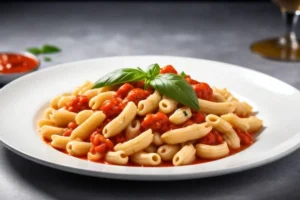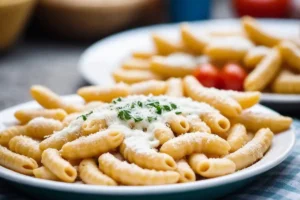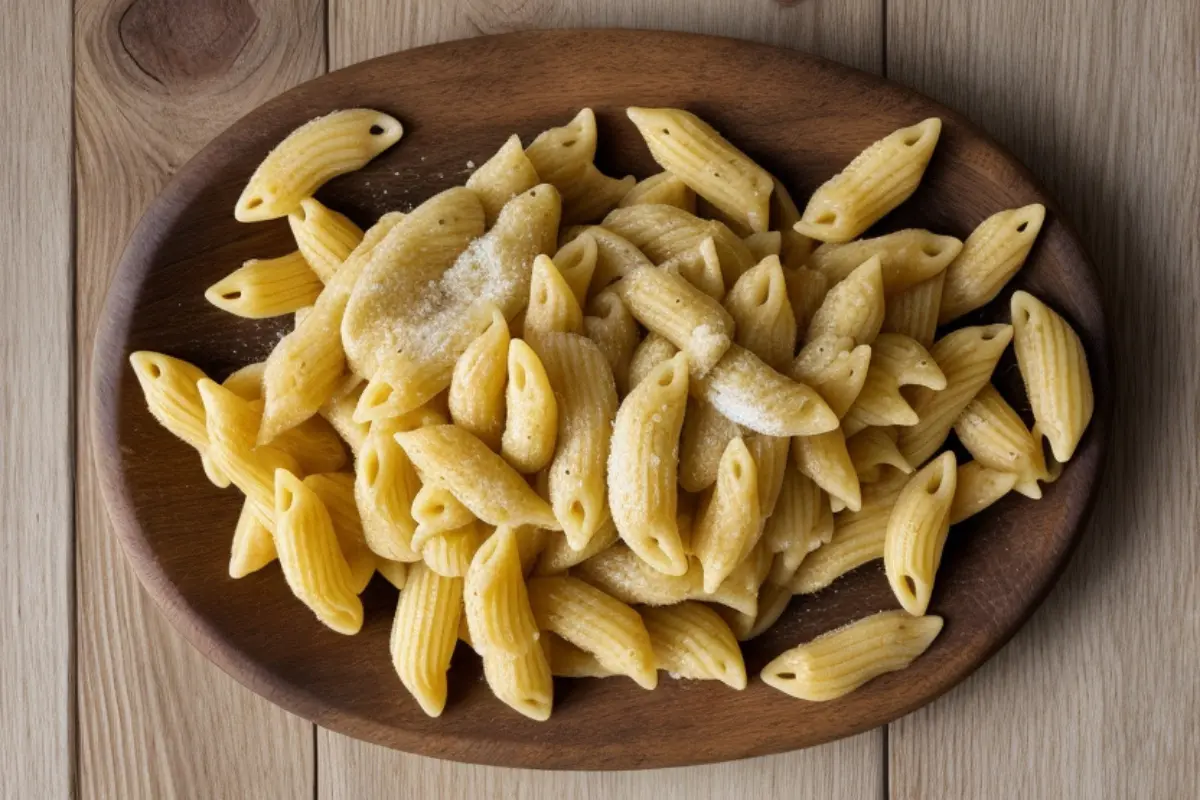In this exploration, we delve into the intriguing question: Does Cavatelli have cheese in it? This beloved pasta has roots deep in Italian tradition, yet many wonder about its typical ingredients. We will uncover the basics of Cavatelli, from its historical background to the variations that might include cheese. By examining how it’s made and served, this article will provide a comprehensive view of Cavatelli, helping you understand its place in Italian cuisine.
Introduction to Cavatelli
What is Cavatelli?
Cavatelli, a classic of Italian pasta, boasts a unique, diminutive shape. Does Cavatelli have cheese in it? Typically, no. The traditional form of Cavatelli involves only flour and water, creating a firm and satisfying texture. Interestingly, it doesn’t usually include eggs or cheese, setting it apart from many other pasta types.
Historical Background and Origin
Cavatelli hails from Southern Italy, particularly thriving in regions like Puglia and Molise. The name derives from ‘cavato,’ meaning ‘hollowed out,’ which aptly describes the pasta’s small, hollow shape. Traditionally, Cavatelli was a special-occasion dish, enjoyed during feasts and large family gatherings.
Overview of Common Ingredients
At its core, Cavatelli consists of simple ingredients: flour and water. Occasionally, some regional recipes may incorporate ricotta, creating a ricotta Cavatelli variant. However, mainstream Cavatelli remains free of cheese, focusing on the pure flavors of its dough. This simplicity allows the pasta to pair wonderfully with a variety of sauces, from light vegetable preparations to heartier meat-based ragùs.
In the next section, we will dive deeper into the specific ingredients that make up traditional Cavatelli and explore whether any cheese variants exist within this culinary tradition. Stay tuned as we continue to unravel the delicious secrets of Cavatelli pasta.
Ingredients in Traditional Cavatelli
Flour and Water – The Basics
At the heart of traditional Cavatelli is a blend of flour and water. This mixture forms a dough that is malleable yet firm enough to be shaped into the pasta’s characteristic small, hollow forms. The simplicity of the ingredients highlights the pasta’s rustic origins, where basic staples were transformed into delightful culinary creations.
The Absence of Cheese in Traditional Recipes
So, does Cavatelli have cheese in it? In its most authentic form, Cavatelli does not include cheese. The focus remains on the pasta’s texture and shape, which are designed to hold onto sauces and condiments effectively. While cheese may be a common addition in other pasta dishes, traditional Cavatelli recipes celebrate the subtle flavors of the dough itself. However, as culinary traditions evolve, some modern interpretations have begun to incorporate cheese, offering a richer taste profile.
In exploring these variations, we find that while traditional Cavatelli shuns the inclusion of cheese, contemporary recipes sometimes add this ingredient to cater to diverse palates. This shift illustrates the adaptability of Italian cuisine to modern tastes while respecting its historical roots. In the next part, we’ll look at how these variations come to life in different regions of Italy and how they’re adapted in today’s kitchens.
Variations of Cavatelli
Regional Variations Across Italy
Cavatelli shows a charming diversity across Italy, with each region tailoring the basic recipe to local tastes and ingredients. For instance, in some areas of Southern Italy, especially where dairy farming is prevalent, ricotta is added to the dough to create a softer, richer version known as ricotta Cavatelli. This adaptation not only enriches the flavor but also adds a slight creaminess to the pasta, distinguishing it from the traditional version. To explore how this variant is made, consider checking this simple guide on how to make homemade Cavatelli. In Molise, people traditionally serve Cavatelli with a hearty pork sausage ragù, while in Puglia, it might feature ricotta, adding richness and creaminess to the dish. For a deeper understanding of how Cavatelli adapts to different regional cuisines and why it remains a favorite pasta shape, explore this insightful discussion on “Cavatelli Pasta – Not Another Cooking Show”.
| Region | Ingredients | Preparation Technique | Typical Pairings |
|---|---|---|---|
| Molise | Flour, water | Hand-rolled, indent with fingers | Pork sausage ragù |
| Puglia | Flour, water, ricotta (optional) | Hand-rolled, indent with fingers | Tomato sauce, seafood |
| Calabria | Semolina flour, water | Shorter lengths, use index finger | ‘Nduja (spicy spreadable sausage), veggies |
| Sicily | Flour, semolina, water | Hand-rolled, longer lengths | Pesto, fresh tomatoes |

Modern Adaptations with Cheese
As we’ve noted, traditional Cavatelli does not typically include cheese. However, modern culinary innovation has embraced cheese as a versatile addition to Cavatelli. Chefs and home cooks alike experiment with various cheeses, such as Parmesan or pecorino, to enhance the pasta’s flavor profile. These adaptations are particularly popular outside Italy, where blending local ingredients with traditional recipes is common.
Popular Cavatelli Recipes with Cheese
In today’s global kitchen, cavatelli cheese content has become a topic of creative culinary experiments. Some popular recipes include Cavatelli with a creamy gorgonzola sauce or tossed with mozzarella and fresh basil for a simple yet delicious dish. For a traditional recipe that incorporates broccoli, a classic Italian vegetable, see this Cavatelli and broccoli recipe, which showcases how to integrate vegetables with Cavatelli in a delightful way.
Each variation of Cavatelli, whether sticking to the roots or branching out with new ingredients, shows the pasta’s versatility and enduring popularity. As we continue, we will explore how to make this delightful pasta at home, emphasizing both traditional methods and modern twists that include cheese. This hands-on approach will give you the tools to bring both the classic and contemporary versions of Cavatelli to your table.
How to Make Cavatelli
Equipment Needed
Making Cavatelli at home is a rewarding endeavor that doesn’t require specialized equipment. Essential tools include a large flat surface for kneading the dough, a knife or dough cutter for shaping, and perhaps a gnocchi board or the tines of a fork to create the pasta’s signature ridges. These simple tools reflect the rustic origins of Cavatelli and demonstrate that great culinary creations often come from humble beginnings.
Step-by-Step Guide to Making Cavatelli
Here’s how you can bring the tradition of Cavatelli into your own kitchen:
- Start with the Dough: Mix flour and water to form a stiff dough. If you’re experimenting with a cheese variant, this is when you’d add ricotta or another soft cheese to the mixture.
- Knead the Dough: Spend about 10 minutes kneading the dough until it’s smooth and elastic. Let it rest for at least 30 minutes, which makes it easier to shape.
- Shape the Pasta: Cut small pieces of dough and roll them into long “snakes”. Cut these into small segments, then press and roll each piece across a board or fork to form the classic Cavatelli shape.
- Cook the Cavatelli: Boil the pasta in salted water until it floats to the surface, indicating it’s perfectly cooked. For detailed cooking times and tips, refer to this guide on how long to cook fresh Cavatelli.

The process of making Cavatelli is as simple as it is therapeutic, turning basic ingredients into a feast for the senses. The tactile pleasure of kneading the dough and the satisfaction of seeing your own pasta take shape make this an enjoyable culinary project.
In the next section, we will delve into how best to serve Cavatelli, highlighting traditional and contemporary sauces and the best cheese toppings to complement this unique pasta. Whether you choose a classic or a modern approach, Cavatelli offers a versatile base for a variety of delicious dishes.
Serving and Pairing Cavatelli
Traditional Pairings and Sauces
Cavatelli, with its hollow shape and firm texture, is particularly adept at holding onto sauces, making it an excellent choice for a variety of pairings. Traditionally, it is served with a simple tomato sauce or a hearty meat ragù. These sauces seep into the cavities of each pasta piece, ensuring every bite is flavorful. In regions of Southern Italy, a favorite is Cavatelli served with broccoli rabe and garlic, a dish that balances the bitterness of the greens with the starchy pasta.
Recommended Cheeses for Topping Cavatelli
While traditional Cavatelli does not include cheese in the dough, adding cheese as a topping is a popular choice that enhances the dish’s flavors. Parmesan, pecorino, or a sprinkle of ricotta salata are excellent choices. These cheeses offer a salty, tangy contrast to the mild pasta, elevating the overall taste experience. For those who prefer a richer dish, a dollop of fresh ricotta mixed into a tomato-based sauce can add a creamy texture that complements the pasta’s simplicity.
Cavatelli’s ability to pair with a broad range of ingredients from simple garden vegetables to rich, decadent cheeses demonstrates its versatility. Whether you opt for the simplicity of a basil-infused tomato sauce or the richness of a creamy gorgonzola sauce, Cavatelli adapts beautifully to both traditional and innovative culinary approaches. In the next section, we’ll explore the nutritional profile of Cavatelli, providing insights into why this pasta is not only delicious but also a beneficial part of a balanced diet.
Nutritional Profile of Cavatelli
avatelli, which is primarily made from flour and water, has a simple nutritional profile that can be adjusted to suit different dietary requirements. Understanding the nutritional aspects of Cavatelli helps to appreciate not just its culinary versatility but also its place in a healthy diet.
Caloric Content and Nutritional Breakdown
A serving of basic Cavatelli provides carbohydrates necessary for energy, with minimal fat and no added sugars, making it a suitable option for many. The calorie count typically depends on the flour used—whole wheat flour, for example, offers more fiber and nutrients than white flour. Moreover, adding cheese either to the dough or as a topping boosts the protein content and provides calcium and other vital nutrients, although it also raises the calorie count.
Cavatelli’s nutritional value can be enhanced by pairing it with nutrient-rich sauces and toppings. Combining Cavatelli with vegetables like spinach or broccoli rabe adds vitamins and minerals, while a lean protein sauce can make it part of a balanced meal. This makes Cavatelli not only a comforting choice but also a customizable one that can fit into various dietary plans.
In the next section, we will address some frequently asked questions about Cavatelli, clearing up common misconceptions and providing further insights into this beloved pasta. Whether you are curious about its preparation, variations, or dietary information, the FAQ section aims to provide comprehensive answers to enhance your understanding and appreciation of Cavatelli.
Conclusion: The Essence of Cavatelli
Exploring the question, “Does Cavatelli have cheese in it?” reveals much about the traditional and evolving practices in Italian cuisine. Cavatelli, a pasta that prides itself on its simplicity and historical roots, traditionally contains no cheese. This simple combination of flour and water showcases the pasta’s ability to take on the rich flavors of its accompanying sauces and ingredients.
Throughout this exploration, we’ve uncovered that while the classic version remains popular, contemporary variations that include cheese cater to diverse tastes and dietary preferences. Cavatelli’s adaptability makes it a beloved choice in both traditional and modern kitchens around the world. Whether served with a simple garlic and oil sauce or a rich, creamy cheese sauce, Cavatelli continues to be a testament to the versatility and enduring popularity of Italian pasta dishes.
In embracing both the traditional and the innovative, Cavatelli remains a fundamental part of Italy’s culinary heritage, inviting pasta lovers everywhere to experience its unique texture and delightful capacity for sauce. Whether making it at home or enjoying it at a restaurant, Cavatelli offers a delicious way to enjoy the art of Italian cooking.
Frequently Asked Questions (FAQs) About Cavatelli
Does Cavatelli Typically Contain Cheese?
One common question revolves around whether Cavatelli has cheese in it. Traditionally, Cavatelli does not include cheese in its basic formulation, which consists simply of flour and water. However, some modern recipes and regional variants incorporate ricotta or other cheeses to add richness.
What are Cavatelli Made Of?
Cavatelli, made primarily from flour and water, is a type of pasta. People knead this simple combination into a dough, shape it into small, hollow forms, and then cook it by boiling. Some variations might include semolina flour for a firmer texture or ricotta for added moisture and flavor.
Does Cavatelli Have Dairy?
In its traditional form, Cavatelli does not contain dairy. It is an eggless pasta that relies solely on water and flour for its dough. However, as with many dishes, variations exist, and some Cavatelli recipes might include dairy, particularly through the addition of ricotta cheese within the dough or cheese as a topping in various recipes.
What’s the Difference Between Cavatelli and Gnocchi?
Cavatelli and gnocchi are both traditional Italian pastas but differ significantly in ingredients and texture. Gnocchi typically consists of potatoes, flour, and eggs, creating a soft, pillowy texture. In contrast, Cavatelli is typically firmer, made without eggs, and often without any dairy, focusing instead on the dough’s shape to capture sauce effectively.
What is the Difference Between Pasta and Cavatelli?
While Cavatelli is a type of pasta, not all pastas are Cavatelli. The term “pasta” encompasses a broad range of shapes and sizes made from various dough formulations. Cavatelli specifically refers to small, hollow-shaped pasta made from an eggless dough, characterized by its ability to hold sauces well due to its shape.
These FAQs aim to clear up some of the common queries regarding Cavatelli, showcasing its unique attributes within the vast world of pasta. Whether you’re a seasoned pasta maker or new to the world of Italian cuisine, understanding these aspects can help deepen your appreciation for Cavatelli’s culinary charm and versatility.

